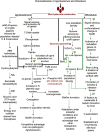The roles of plant phenolics in defence and communication during Agrobacterium and Rhizobium infection
- PMID: 20696007
- PMCID: PMC6640454
- DOI: 10.1111/j.1364-3703.2010.00625.x
The roles of plant phenolics in defence and communication during Agrobacterium and Rhizobium infection
Abstract
Phenolics are aromatic benzene ring compounds with one or more hydroxyl groups produced by plants mainly for protection against stress. The functions of phenolic compounds in plant physiology and interactions with biotic and abiotic environments are difficult to overestimate. Phenolics play important roles in plant development, particularly in lignin and pigment biosynthesis. They also provide structural integrity and scaffolding support to plants. Importantly, phenolic phytoalexins, secreted by wounded or otherwise perturbed plants, repel or kill many microorganisms, and some pathogens can counteract or nullify these defences or even subvert them to their own advantage. In this review, we discuss the roles of phenolics in the interactions of plants with Agrobacterium and Rhizobium.
Figures




Similar articles
-
Phenolic acids act as signaling molecules in plant-microbe symbioses.Plant Signal Behav. 2010 Apr;5(4):359-68. doi: 10.4161/psb.5.4.10871. Epub 2010 Apr 7. Plant Signal Behav. 2010. PMID: 20400851 Free PMC article. Review.
-
Plant phenolics: recent advances on their biosynthesis, genetics, and ecophysiology.Plant Physiol Biochem. 2013 Nov;72:1-20. doi: 10.1016/j.plaphy.2013.05.009. Epub 2013 May 28. Plant Physiol Biochem. 2013. PMID: 23774057 Review.
-
Plant phenolic compounds and oxidative stress: integrated signals in fungal-plant interactions.Curr Genet. 2015 Aug;61(3):347-57. doi: 10.1007/s00294-014-0458-6. Epub 2014 Nov 19. Curr Genet. 2015. PMID: 25407462 Review.
-
Plant metabolism and the environment: implications for managing phenolics.Crit Rev Food Sci Nutr. 2010 Aug;50(7):620-43. doi: 10.1080/10408390802603441. Crit Rev Food Sci Nutr. 2010. PMID: 20694925 Review.
-
Plant growth-promoting rhizobacteria-mediated induction of phenolics in pea ( Pisum sativum) after infection with Erysiphe pisi.Curr Microbiol. 2002 Jun;44(6):396-400. doi: 10.1007/s00284-001-0007-7. Curr Microbiol. 2002. PMID: 12000988
Cited by
-
Metabolic effects of agro-infiltration on N. benthamiana accessions.Transgenic Res. 2021 Jun;30(3):303-315. doi: 10.1007/s11248-021-00256-9. Epub 2021 Apr 28. Transgenic Res. 2021. PMID: 33909228 Free PMC article.
-
Hordatines and Associated Precursors Dominate Metabolite Profiles of Barley (Hordeum vulgare L.) Seedlings: A Metabolomics Study of Five Cultivars.Metabolites. 2022 Mar 31;12(4):310. doi: 10.3390/metabo12040310. Metabolites. 2022. PMID: 35448497 Free PMC article.
-
Resistance induction with silicon in Hass avocado plants inoculated with Phytophthora cinnamomi Rands.Plant Signal Behav. 2023 Dec 31;18(1):2178362. doi: 10.1080/15592324.2023.2178362. Plant Signal Behav. 2023. PMID: 36814118 Free PMC article.
-
Insight Into the Microbial Co-occurrence and Diversity of 73 Grapevine (Vitis vinifera) Crown Galls Collected Across the Northern Hemisphere.Front Microbiol. 2019 Aug 13;10:1896. doi: 10.3389/fmicb.2019.01896. eCollection 2019. Front Microbiol. 2019. PMID: 31456792 Free PMC article.
-
The MexE/MexF/AmeC Efflux Pump of Agrobacterium tumefaciens and Its Role in Ti Plasmid Virulence Gene Expression.J Bacteriol. 2020 Mar 26;202(8):e00609-19. doi: 10.1128/JB.00609-19. Print 2020 Mar 26. J Bacteriol. 2020. PMID: 32015146 Free PMC article.
References
-
- Adams, N.R. (1989) Phytoestrogens In: Toxicants of Plant Origin (Cheeke P.R., ed.), pp. 23–51. Boca Raton: CRC Press.
-
- Aguilar, J.M.M. , Ashby, A.M. , Richards, A.J.M. , Loake, G.J. , Watson, M.D. and Shaw, C.H. (1988) Chemotaxis of Rhizobium leguminosarum biovar phaseoli towards flavonoid inducers of the symbiotic nodulation genes. J. Gen. Microbiol. 134, 2741–2746.
-
- Akhtar, M. and Malik, A. (2000) Roles of organic soil amendments and soil organisms in the biological control of plant‐parasitic nematodes: a review. Bioresour. Technol. 74, 35–47.
-
- Akiyama, K. (2007) Chemical identification and functional analysis of apocarotenoids involved in the development of arbuscular mycorrhizal symbiosis. Biosci. Biotechnol. Biochem. 71, 1405–1414. - PubMed
-
- Akiyama, K. , Matsuzaki, K. and Hayashi, H. (2005) Plant sesquiterpenes induce hyphal branching in arbuscular mycorrhizal fungi. Nature, 435, 824–827. - PubMed
Publication types
MeSH terms
Substances
LinkOut - more resources
Full Text Sources
Other Literature Sources

